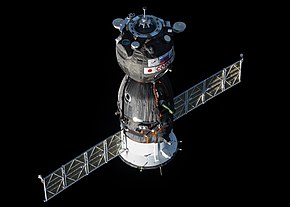 Soyuz MS-20 approaching the ISS | |||
| Manufacturer | Energia | ||
|---|---|---|---|
| Country of origin | Russia | ||
| Operator | Roscosmos | ||
| Specifications | |||
| Spacecraft type | Crewed spaceflight | ||
| Launch mass | 7,080 kg (15,610 lb) | ||
| Crew capacity | 3 | ||
| Volume | 10.5 m3 (370 cu ft) | ||
| Batteries | 755 Ah | ||
| Regime | Low Earth orbit | ||
| Design life | 210 days when docked to International Space Station (ISS) | ||
| Dimensions | |||
| Solar array span |
| ||
| Width | 2.72 m (8 ft 11 in) | ||
| Production | |||
| Status | Active | ||
| Built | 24 | ||
| Launched | 24 (as of 15 Sep 2023) | ||
| Operational | 2 | ||
| Retired | 22 (not including MS-10) | ||
| Failed | 1 (Soyuz MS-10) | ||
| Maiden launch | Soyuz MS-01 (7 July 2016) | ||
| Last launch | Active | ||
| Related spacecraft | |||
| Derived from | Soyuz TMA-M | ||
| |||
The Soyuz MS (Russian: Союз МС; GRAU: 11F732A48) is a revision of the Russian spacecraft series Soyuz first launched in 2016. It is an evolution of the Soyuz TMA-M spacecraft, with modernization mostly concentrated on the communications and navigation subsystems. It is used by Roscosmos for human spaceflight. The Soyuz MS has minimal external changes with respect to the Soyuz TMA-M, mostly limited to antennas and sensors, as well as the thruster placement.[2]
The first launch was Soyuz MS-01 on 7 July 2016, aboard a Soyuz-FG launch vehicle towards the International Space Station (ISS).[3] The trip included a two-day checkout phase for the design before docking with the ISS on 9 July 2016.[4]
- ^ "Soyuz MS". Spaceflight 101.
- ^ Cite error: The named reference
popularmechanics-20160705was invoked but never defined (see the help page). - ^ Cite error: The named reference
tass-enscience886832was invoked but never defined (see the help page). - ^ Cite error: The named reference
rsw-soyuzms01was invoked but never defined (see the help page).